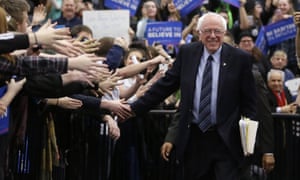Dan Roberts in Washington
A ferocious week of attacks on Donald Trump appeared to loosen his grip on the Republican presidential race on “Super Saturday”, while Bernie Sanders showed there may also be some life left in the Democratic race.
Conservative champion Ted Cruz won heavily in the Republican caucus in Kansas and won by a similar margin in Maine, before Trump underlined his national advantage with victories in Louisiana and Kentucky.
With 47 delegates up for grabs, Louisiana was the biggest prize of the night and the only state using a primary rather than caucus system. Trump has tended to do better in primaries, where his support among first-time voters and independents can overwhelm the more determined activists who back Cruz.
Trump’s victories – by 4.4% in Louisiana and 3.6% in Kentucky – were by smaller margins than Cruz won his states, meaning the Texan took more delegates on the night. The results suggested neither may reach the 1,237 delegates needed to win the Republican nomination outright.
In a speech from Florida delivered after Kentucky was called, Trump fired a warning shot at party leaders tempted to use a so-called brokered convention to introduce fresh candidates, something that could prompt him to run as an independent.
“If they run a third party it will make it impossible for the Republican party to win,” said Trump, warning that a Democratic victory in November could result in a lasting liberal takeover of the supreme court.
“Marco Rubio had a very, very bad night,” he added. ‘I think it’s time he drops out of the race.”
Trump also defended his reference to his penis size in the last TV debate – “I didn’t bring it up, [Rubio] brought it up, but I finished it” – but appeared unwilling to let the initial attacks on the size of his hands go by without one last reference to his golf swing.
“Do I hit the ball good?” he asked. “Do I hit the ball long? Is Trump strong? Huh?”
In the Democratic race, Hillary Clinton lost Kansas and Nebraska to a resurgent Sanders campaign, although her own win in Louisiana, as expected, left her well ahead in net delegates at the end of the night.
Though not as significant as the dozen Super Tuesday contests this week or the large states voting on 15 March, the five states voting on Saturday suggested the race to secure party nominations was far from settled.
In Kansas, Cruz won by 48.2%-23.3% over Trump, narrowly missing becoming the first Republican to win 50% of the vote in any state. He also celebrated an unofficial but symbolic win on Saturday in a straw poll among activists at the Conservative Political Action Conference (CPAC) in Washington.
“By any measure, Kansas, CPAC and Maine are all very different sets of voters and I think what it represents is a Republican party coalescing against Donald Trump,” the Texas senator said, at a press conference in Idaho.

Rivets rattling on GOP flight #2016
Read more
Cruz had already shown his popularity among Christian evangelicals and the Tea Party with wins in Iowa, Texas and Oklahoma, but his strong performance in Maine may suggest that a wider group of Republican voters is beginning to tire of Trump’s controversial theatrics.
This week, after another raucous television debate, he was declared a “fraud” by former nominee Mitt Romney and denounced as a national security risk bydozens of Republican foreign policy veterans.
Cruz tried to paint himself, not the distant-third Rubio, as the most likely candidate to prevent Trump from winning a majority of delegates before the convention, but also an inheritor of the same anti-establishment wave. Rubio finished fourth of four in Maine, behind even John Kasich, who is pinning all his hopes on his own state, Ohio, and thus missed out on any delegates at all.
“God bless the great state of Idaho,” Cruz said. “And while we’re at it, let me say God bless Kansas and God bless Maine.” Idaho votes on Tuesday 8 March.
“Now it’s a little bit early, the votes are still being counted … but we have roughly 50% of the vote, and the scream you hear, the howl you hear from Washington DC, is utter terror at what we the people are doing together.”
FacebookTwitterPinterest Bernie Sanders greets supporters before speaking at a rally in Michigan on Saturday. Photograph: Carlos Osorio/AP
Analysis To Trump, or not to Trump: CPAC crowd ponders an existential question
The gathering of the conservative clans was spared a speech but as voting went on elsewhere, there was angst in the halls and out among the bookstalls
Read more
The Democratic race was harder to read, though there were signs a strong turnout helped Sanders beat Clinton in Nebraska and Kansas.
In an echo of his performance on Super Tuesday, however, Sanders faced an uphill battle in Louisiana, particularly with African American voters. Worth 51 delegates, Clinton’s southern stronghold gave her 70% of the vote.
After Saturday’s voting, according to the Associated Press, Clinton had 1,104 delegates top 446 for Sanders. The winning total is 2,383.
In the Republican race, Trump has 378 delegates, Cruz 295 and Rubio 123. The threshold is 1,237.
Sanders hopes that by showing there is still passionate support for him in states so far outside his New England stronghold, he can regather momentum for bigger battles in states like Michigan and Ohio.
“We’re in an intense stretch of the campaign where success for Bernie means the political and media establishment must take note,” said campaign manager Jeff Weaver, in an email to supporters on Saturday.




 President Kwame Nkrumah of Ghana and president John F. Kennedy at a news conference in the White House on March 8, 1961.(AP Photo/WCA)
President Kwame Nkrumah of Ghana and president John F. Kennedy at a news conference in the White House on March 8, 1961.(AP Photo/WCA)







